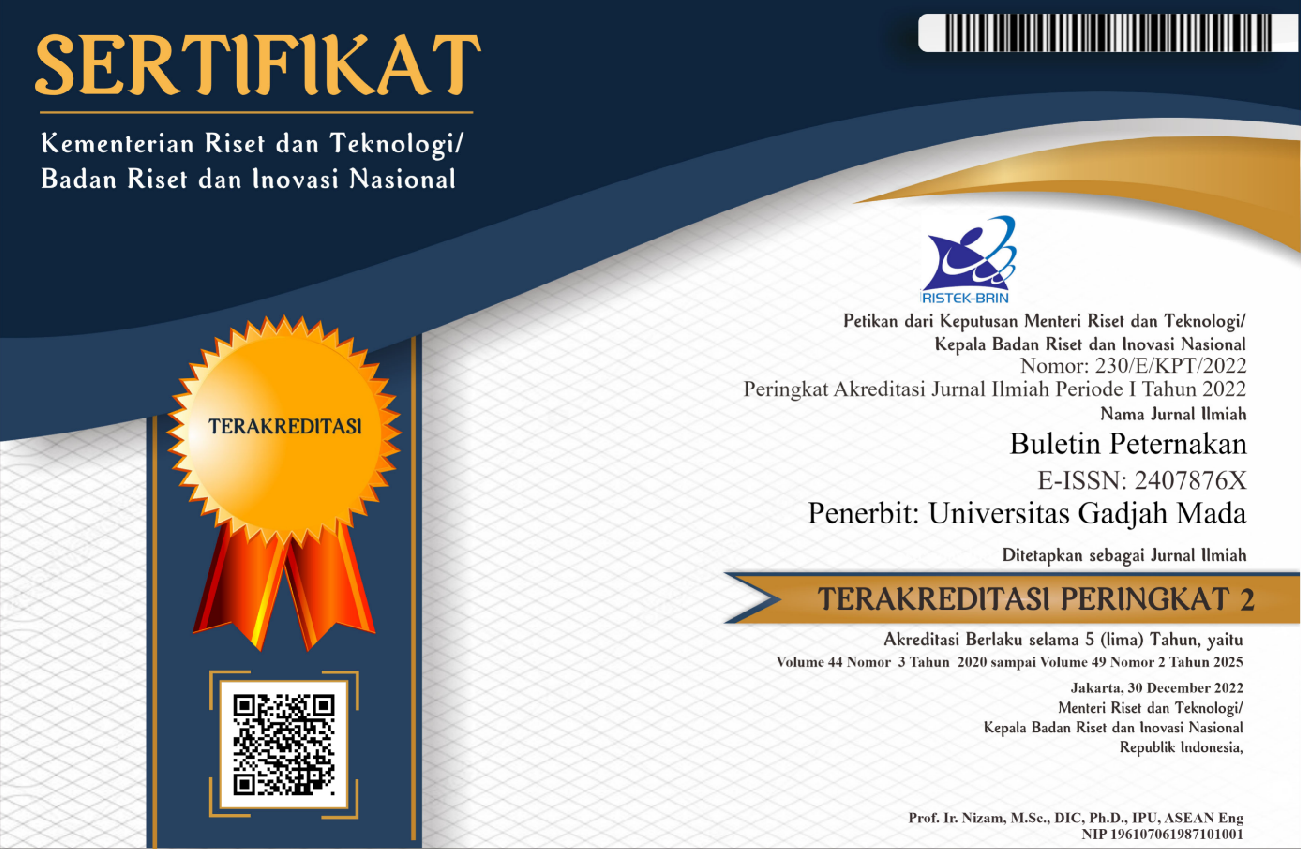Microsatellite-Based Genetic Diversity Among Three Duck Populations in Sumatera Island
Dyah Maharani(1*), Dwi Nur Happy Hariyono(2), Jafendi Hasoloan Purba Sidadolog(3), Sunghyun Cho(4), Prabuddha Manjula(5), Dongwon Seo(6), Nuri Choi(7), Jun Heon Lee(8)
(1) Departement of Animal Breeding and Reproduction, Faculty of Animal Science, Universitas Gadjah Mada, Yogyakarta, 55281, Indonesia
(2) Departement of Animal Breeding and Reproduction, Faculty of Animal Science, Universitas Gadjah Mada, Yogyakarta, 55281, Indonesia
(3) Departement of Animal Breeding and Reproduction, Faculty of Animal Science, Universitas Gadjah Mada, Yogyakarta, 55281, Indonesia
(4) Division of Animal and Dairy Science, College of Agriculture and Life Sciences, Chungnam National University, Daejeon, 34134, Korea
(5) Division of Animal and Dairy Science, College of Agriculture and Life Sciences, Chungnam National University, Daejeon, 34134, Korea
(6) Division of Animal and Dairy Science, College of Agriculture and Life Sciences, Chungnam National University, Daejeon, 34134, Korea
(7) Division of Animal and Dairy Science, College of Agriculture and Life Sciences, Chungnam National University, Daejeon, 34134, Korea
(8) Division of Animal and Dairy Science, College of Agriculture and Life Sciences, Chungnam National University, Daejeon, 34134, Korea
(*) Corresponding Author
Abstract
This study aimed to determine the genetic diversity among three duck populations (Bayang, Pegagan, and Pitalah) reared in Sumatera island, Indonesia, using microsatellite markers. Genetic diversity among populations (n = 90) was determined using 22 microsatellite markers, based on several indices: number of alleles (Na), observed heterozygosity (Ho), expected heterozygosity (He), polymorphism information content (PIC), and Wright’s F-statistics ( ). The total number of alleles detected across loci was 121. The Na per locus ranged from 2 (APH24, CAUD128, and CAUD009) to 18 (CAUD048 and CAUD040). The mean Ho (0.429) dan He (0.509) indicated that the level of genetic diversity among populations was moderate, while the mean PIC (0.46) suggested that the tested loci were informative for assessing genetic diversity. The mean F-statistics ( ) were 0.148, 0.198, and 0.060, respectively. The value indicated that the level of genetic differentiation among populations was moderate. The results confirms a moderate genetic diversity among populations, which could be beneficial for designing conservation and utilization of the local ducks in Sumatera island.
Keywords
Full Text:
PDFReferences
Ahmadi, A. K., G. Rahimi, A. Vafaei, and H. Sayyazadeh. 2007. Microsatellite analysis of genetic diversity in Pekin (Anas platyrhynchos) and Muscovy (Cairina moschata) duck populations. Int. J. Poult. Sci. 6: 378-382.
Bennett, P. 2000. Microsatellites. J Clin Pathol Mol Pathol. 53: 177–83.
Botstein, D., R. L. White, M. Skolnik, and R. W. Davis. 1980. Construction of a genetic linkage map in man using restriction fragment length polymorphisms. Am J Hum Genet. 32: 314–31.
Brahmantiyo, B., A. R. Setioko, and L. H. Prasetyo. 2002. Karakteristik pertumbuhan Itik Pegagan sebagai sumber plasma nuftah ternak. Proseding Seminar Nasional Teknologi Peternakan dan Veteriner, Bogor.
Hariyono, D. N. H, D. Maharani, S. Cho, P. Manjula, D. Seo, N. Choi, J. H. P. Sidadolog, and J. H. Lee. 2019. Genetic diversity and phylogenetic relationship analyzed by microsatellite markers in eight Indonesian local duck populations. Asian-Australas J. Anim. Sci. 32: 31-37.
Ismoyowati and D. Purwantini. 2011. Genetic variability of Bali and Alabio ducks on the basis of phenotypic and microsatellites. Asian J. Poult. Sci. 5: 07–15.
Kim, K. S., J. S. Yeo, and C. B. Choi. 2002. Genetic diversity of north-east Asian cattle based on microsatellite data. Anim. Genet. 33: 201-204.
Maharani, D., D. N. H. Hariyono, D. D. I. Putra, J. H. Lee, and J. H. P. Sidadolog. 2019. Phenotypic characterization of local female duck populations in Indonesia. Journal of Asia-Pacific Biodiversity. 12: 508-514.
Maharani, D., D. H. H. Hariyono, S. Cho, P. Manjula, D. Seo, N. Choi, J. H. P. Sidadolog, and J. H. Lee. 2018. Analysis of genetic diversity Indonesian ducks using microsatellite marker. Paper presented at the Livestock Genomics Conference. Cambridge: September 21-22, 2018.
Marshall, T. C., J. Slate, L. E. B. Kruuk, and J. M. Pemberton. 1998. Statistical confidence for likelihood-based paternity inference in natural populations. Mol. Ecol. 7: 639-655.
Peakall, R. and P. E. Smouse. 2012. GenAlEx 6.5: genetic analysis in Excel. Population genetic software for teaching and reasearch – an update. Bioinformatics. 28: 2537-2539.
Rusfidra, Y. Heryandi, Jamsari, and E. Y. Rahman. 2013. Variasi genetik Itik Bayang berbasis marka mikrosatelit pada lokus AY287 dan lokus AY283. Sains Peternakan 11: 91-98.
Sari, M. L., R. R. Noor, P. S. Hardjosworo, and C. Nisa. 2011. Keragaman telur tetas Itik Pegagan. Jurnal Sains Peternakan Indonesia. 6: 97-102.
Schlotterer, C. 2000. Evolutionary dynamics of microsatellite DNA. Chromosoma. 109: 365-371.
Sultana, H. D. Seo, N. R. Choi, Y. S. Kim, P. Manjula, M. S. A. Bhuiyan, K. N. Heo, and J. H. Lee. 2017. Genetic diversity analysis of Asian duck populations using 24 microsatellite markers. Korean J. Poult. Sci. 44: 75-81
Wimmers, K., S. Ponsuksili, T. Hardge, A. Valle-Zarate, P. K. Mathur, and Horst. 2000. Genetic distances of African, Asian and South American local chickens. Anim. Genet. 31: 159-165.
Article Metrics
Refbacks
- There are currently no refbacks.

This work is licensed under a Creative Commons Attribution-ShareAlike 4.0 International License.
Buletin Peternakan (Bulletin of Animal Science) Indexed by:

This work is licensed under a Creative Commons Attribution-ShareAlike 4.0 International License.










